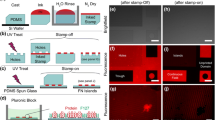Abstract
Polymoiphonuclear leukocytes (PMNLs) were allowed to migrate on slides with fixed yeast particles dotted about on the surface. Locomotion was quantified by counting the number of yeast particles in association with a PMNL, Addition of a complement source to yeast particles able to activate the complement system resulted in a chemotactic response even when fluid-phase attractants were removed prior to the measurement of PMNL chemotaxis, indicating that surface-bound attractants guided the PMNLs to the yeast particles. The presence of high concentrations of fluid-phase chemoattractants resulted in a reduced PMNL chemotactic response to the surface-bound gradient. From comparisons between the yeast-slide system and the locomotion-under-agarose assay, it could be concluded that PMNL chemotaxis in response to a surface-bound gradient is less influenced by factor-specific deactivation than the response to a fluid-phase attractant. The PMNL chemotactic response is reduced to both surface-bound and fluid-phase gradients as a result of a non-factorspecific deactivation.
Similar content being viewed by others
References
Klebanoff, S. J., andR. A. Clark. 1978. The Neutrophil. North-Holland Publishing Co., New York.
Dahlgren, C. 1982. Locomotion and adhesion of polymorphonuclear leukocytes.Cell Biophys. 4:133–141.
Dierich, N. P., W. Sablotny, andG. Till. 1980. Migration of leukocytes into filters coated homogeneously with immune complexes, antigens, lectins or tripeptides.Imtnunobiology 157:47–53.
Repo, H. 1976. Leukocyte migration agarose test for the assessment of human neutrophil chemotaxis. Thesis, University of Helsinki, Finland.
Dahlqren, C., andH. Elwing. 1983. Inhibition of polymorphonuclear leukocyte locomotion by surface bound antigen-antibody complexes.Immunology 49:329–336.
Wilkinson, P. C. 1982. Chemotaxis and Inflammation, 2nd ed. Churchill Livingston, Edinburgh.
Dahlgren, C., J. Hed, andO. Stendahl. 1984. Chemotaxis of polymorphonuclear leukocytes in response to surface-bound complement, derived chemoattractants generated in situ.Inflammation 8:201–208.
Webster, R. O., B. Sanolari, andP. M. Hensox. 1980. Neutrophil Chemotaxis in response to surface bound C5a.Exp. Cell Res. 129:55–62.
Wilkinson, P. C., andR. B. Allan. 1978. Chemotaxis of neutrophil leukocytes towards substratum-bound protein attractants.Exp. Cell Res. 117:403–412.
Issekutz, A. C., andW. D. Biggar. 1977. Influence of serumderived chemotactic factors and bacterial products on human neutrophil chemotaxis.Infect. Immun. 15:212–220.
Ward, P. A., andE. L. Becker. 1968. The deactivation of rabbit neutrophils by chemotactic factor and the nature of the activatible esterase.J. Exp. Med. 127:693–709.
Van Epps, D. E., andB. R. Andersen. 1973. Streptolysin 0 inhibition of neutrophil chemotaxis and mobility: Nonimmune phenomenon with species specificity.Infect. Immun. 9:27–33.
Goetzl, E. J., I. Gigli, S. Wasserman, andK. F. Austen. 1973. A neutrophil immobilizing factor derived from human leukocytes. II. Specificity of action on polymorphonuclear leukocyte mobility.J. Immunol. 111:938–945.
Nelson, R.D., R. T. McCormack, C. D. Fiegel, andR. L. Simmons. 1978. Chemotactic deactivation of human neutrophils: Evidence for nonspecific and specific components.Infect. Immun. 22:441–444.
Nelson, R. D., V. D. Fiegel, J. Herron, J. M. Gracyk, M. P. Bauman, R. T. McCormack, andR. L. Simmons. 1980. Chemotactic deactivation of human neutrophils: Role of stimulation of hexosemonophosphate shunt activity in nonspecific deactivation.Acta Physiol. Scand, Suppl. 492:31–41.
Coble, B. I., C. Dahlgren, J. Hed, andO. Stendahl. 1983. A quantitative microassay for leukocyte chemotaxis, using a microscopic slide system with complement-activation yeast particles as gradient source.J. Immunol. Methods 64:303–311.
Bøyum, A. 1968. Isolation of mononuclear cells and granulocytes from human blood.Scand. J. Clin. Lab. Invest. Suppl. 97:77–89.
Stendahl, O., L. Molin, andC. Dahlgren. 1978. The inhibition of polymorphonuclear leukocyte cytotoxicity by dapsone.J. Clin. Invest. 62:214–220.
Sullivan, S. J., andS. H. Zigmond. 1980. Chemotactic peptide receptor modulation in polymorphonuclear leukocytes.J. Cell Biol 85:703–711.
Zigmond, S. H., andS. J. Sullivan. 1979. Sensory adaption of leukocytes to Chemotactic peptidesJ. Cell. Biol 82:517–527.
Author information
Authors and Affiliations
Rights and permissions
About this article
Cite this article
Dahlgren, C. Influence of fluid-phase chemoattractants on polymorphonuclear leukocyte chemotaxic responsiveness to a surface-bound attractant. Inflammation 9, 81–90 (1985). https://doi.org/10.1007/BF00915414
Issue Date:
DOI: https://doi.org/10.1007/BF00915414




